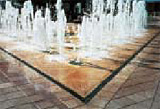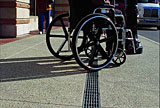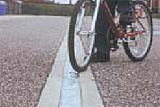 |
The grate is the most visible part of the
trench drain and aesthetically the most
important.
Grates can be selected to ‘blend’ into the
pavement, or used as a feature, or perimeter border.
Once hydraulics, loading and chemical
resistance requirements are met, the decision
is based on visual or cost preferences. |
|
Grate materials - stainless steel, ductile
iron and plastic can all offer
excellent aesthetics. |
|
Grate slot patterns - perforated, slotted,
mesh and decorative patterns are
available. |
|
 |
 |
The Australian Access and Mobility requirements are set out in AS 1428.2 Clause 9(c) |
‘If gratings are located in walking surface, they shall have spaces not more than 13mm wide and not more than 150mm long. If gratings have elongated openings, they shall be placed so that the long dimension is transverse to the dominant direction of travel.' |

The diagram shows the slots transverse to the flow of traffic; this helps prevent wheelchair wheels and walking aids becoming trapped or slipping on the grate surface. |

|
ACO offers a range of ‘Heelguard™’ or Heelsafe™ grates that are designed to prevent small stiletto style heels becoming trapped, causing injury or falls. These grates satisfy the legislative safety requirements of:
ASME A112.6.3 Section 7.12 ‘A grate designed to resist entry of
high-heeled shoes in which the maximum grate hole size in least dimension shall be 5/16in. (8mm)'
|
|
|
|

Bicycle safe grates should not trap or 'tram-line' bicycle wheels. Clause 3.3.6 of AS 3996 : 2005 specifies the maximum slot length dependent on the |
width of slot for grates that are deemed to be 'Bicycle tyre penetration resistant'. |
|
|